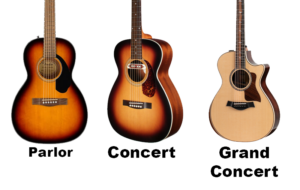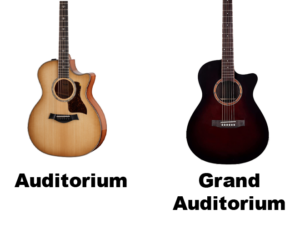Uncategorized
Mastering the Chords for Folsom Prison Blues: A Beginner’s Guide
Embarking on a musical journey with the guitar is like unlocking a treasure chest of melodies and rhythms that bring stories to life. Among the timeless tunes that have captivated generations, “Folsom Prison Blues” by Johnny Cash stands as an iconic example. Learning the chords for “Folsom Prison Blues” is not only a rite of passage for guitarists but also a window into the world of classic country music. In this article, we’ll explore the chords that form the backbone of this beloved song, offer practical fingering tips, and unveil the significance of mastering these chords for your guitar-playing repertoire. Get ready to dive into the chords for “Folsom Prison Blues” and embrace the spirit of the Man in Black!
Introducing the Chords for “Folsom Prison Blues”
“Folsom Prison Blues” features a sequence of chords that create its distinct and recognizable sound. The chords used in the song are E, A, and B7. While these chords may seem simple, they come together to form the foundation of the song’s rhythmic and melodic structure.
Playing the Chords for “Folsom Prison Blues”
Follow these steps to master the chords for “Folsom Prison Blues”:
1. E Chord: Begin with the E chord. Place your index finger on the 1st fret of the G string (third from the top), your middle finger on the 2nd fret of the A string (second from the top), and your ring finger on the 2nd fret of the D string (fourth from the top). Strum from the low E string to the high E string (thinnest string).
2. A Chord: Transition to the A chord. Keep your index finger in place and move your middle and ring fingers to the 2nd fret of the D and G strings, respectively. Strum from the A string to the high E string.
3. B7 Chord: Finally, play the B7 chord. Place your index finger on the 1st fret of the D string, your middle finger on the 2nd fret of the A string, and your ring finger on the 2nd fret of the G string. Strum from the A string to the high E string.
Benefits of Learning the Chords for “Folsom Prison Blues”
Mastering the chords for “Folsom Prison Blues” offers several benefits for guitarists:
1. Classic Repertoire: Learning this iconic song introduces you to the world of classic country music and adds a timeless tune to your repertoire.
2. Rhythm and Timing: Practicing the chords enhances your sense of rhythm and timing, helping you develop steady strumming patterns and groove.
3. Song Interpretation: As you become proficient with the chords, you can experiment with different strumming styles, dynamics, and embellishments to put your unique stamp on the song.
Practical Tips for Mastering the Chords for “Folsom Prison Blues”
Here are some practical tips to help you excel in playing the chords for “Folsom Prison Blues”:
1. Finger Placement: Focus on placing your fingers accurately and pressing down firmly on the strings. This ensures that each chord rings out clearly without any muted or buzzing notes.
2. Chord Transitions: Practice transitioning between the E, A, and B7 chords smoothly. Start slowly and gradually increase your speed as you become more comfortable.
3. Strumming Patterns: Experiment with different strumming patterns to create various textures and dynamics. Try strumming with your fingers or using a pick, and feel free to incorporate pauses and accents for added flair.
Famous Songs Featuring the Chords for “Folsom Prison Blues”
“Folsom Prison Blues” is not only a classic itself but has also inspired various renditions and covers by artists across genres. Here are a few examples:
1. “Folsom Prison Blues” by Johnny Cash: The original version by the Man in Black remains a timeless and influential classic.
2. “Live at Folsom Prison” Album: Johnny Cash’s live album, recorded at Folsom State Prison, features an electrifying performance of the song that captures the essence of the live experience.
3. “Folsom Prison Blues” by Everlast: This bluesy and soulful rendition adds a fresh twist to the iconic tune, showcasing its adaptability across different musical styles.
Conclusion: Embrace the Music’s Heartbeat!
Congratulations, you’ve ventured into the world of “Folsom Prison Blues” and its captivating chords! By mastering these chords, you’ve connected with the rich heritage of classic country music and added a timeless piece to your musical arsenal. Whether you’re strumming along to Johnny Cash’s iconic rendition or putting your spin on the song, the chords for “Folsom Prison Blues” offer a gateway to rhythmic storytelling and emotional expression.
As you continue your guitar-playing journey, remember that practice and dedication are key to mastering any song. Embrace the challenges, celebrate your progress, and let your love for music guide you forward. With consistent effort and a passion for learning, you’ll find yourself playing “Folsom Prison Blues” effortlessly and infusing it with your unique style.
The chords for “Folsom Prison Blues” are just the beginning of your musical odyssey. As you explore further, you’ll encounter a diverse array of songs, techniques, and musical concepts that will enrich your playing and allow you to create melodies that resonate with your heart and soul. So, keep strumming, keep learning, and most importantly, keep enjoying the wonderful journey of creating music with your guitar. Happy playing!
Uncategorized
Acoustic Guitar Sizes: Finding Your Perfect Fit
Have you ever wondered how the size of an acoustic guitar affects its sound? From the intimate, focused tones of a parlor guitar to the deep, resonant sound of a jumbo, the size and shape of an acoustic guitar can have a profound impact on its sonic characteristics.”
In this article, we’ll explore acoustic guitar sizes, their variations, and how to choose the perfect size that suits your needs.
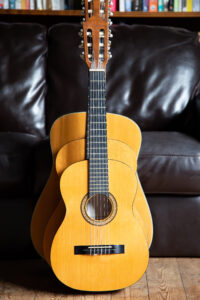 Understanding Acoustic Guitar Sizes: A Musical Puzzle
Understanding Acoustic Guitar Sizes: A Musical Puzzle
Acoustic guitar sizes refer to the dimensions and proportions of the guitar body, which significantly influence the instrument’s tonal characteristics, projection, and playability.
Just like pieces of a musical puzzle, different sizes create distinct voices that cater to various playing styles and preferences.
The Spectrum of Acoustic Guitar Sizes
Acoustic guitars come in several sizes, each with its unique qualities and attributes. Let’s explore some common acoustic guitar sizes and their defining features:
-
-
Parlor Guitar: The parlor guitar is petite and charming, making it an ideal companion for intimate settings.
The name comes from the rooms in which the guitar was typically played in the late 19th century.
Some famous musicians who have been known to use the parlor guitar are, Eric Clapton, Mark Orton, Ed Sheehan, and John Mayer
Its smaller size results in a focused and balanced sound, perfect for fingerpicking and folk music.
-
Concert Guitar: Slightly larger than the parlor guitar, the concert guitar offers enhanced projection and volume. It strikes a balance between portability and sound, making it versatile for various genres.
It is often used in classical music and flamenco music with its full sound.
-
Grand Concert Guitar: With a larger body than the concert guitar, the grand concert guitar boasts a fuller sound and improved tonal complexity.
A popular choice for those who have a smaller stature and require an instrument that’s built to a shorter scale. Great choice for traveling musicians who often play live performances.
It’s suitable for fingerstyle playing and intricate arrangements.
-
Auditorium Guitar: The auditorium guitar, also known as the orchestra model (OM), features a well-rounded sound with a pronounced midrange.
More shallower than the dreadnought and narrower in width than a concert guitar. An Auditorium guitar brings the body closer to the player, making it feel more intimate and comfortable for stage use.
Some famous musicians who play it include Ed Sheeran, John Mayer, and Eric Clapton.
-
Grand Auditorium Guitar: Expanding on the auditorium guitar’s design, the grand auditorium guitar offers a versatile sound profile with enhanced bass response and overall volume.
It is a versatile mid-sized guitar that is a good choice for those who want a single guitar to travel with. The tone is great for strumming and picking. It performs well on stage and in the studio.
It suits a wide range of musical genres.
-
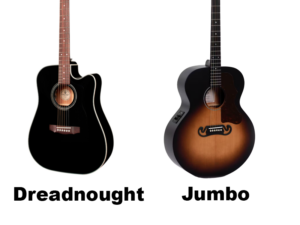 Dreadnought Guitar: The Dreadnought is a true icon, known for its bold and powerful sound. Its large body produces a strong bass response, making it ideal for strumming and vocal accompaniment.
Dreadnought Guitar: The Dreadnought is a true icon, known for its bold and powerful sound. Its large body produces a strong bass response, making it ideal for strumming and vocal accompaniment.This guitar is known for its powerful voice and lower-mid-rich tones that make it a favored choice for country artists. Although it is a popular choice for musicians of all genres.
Some famous musicians who play the dreadnought guitar include Hank Williams Jr, Elvis Presley, Keith Richards, Thom Yorke, and Kurt Cobain.
The original dreadnought guitars were made for the Oliver Ditson Company and featured mahogany backs and sides and spruce tops.
-
Jumbo Guitar: The jumbo guitar lives up to its name with a massive body that delivers robust volume and a deep bass presence.
This is the largest of the guitar family with a deeper body than the popular dreadnought. The body is wider and deeper than traditional acoustic guitars, which gives them a unique appearance.
Jumbo’s are well suited to rhythm guitarists in country and folk rock, and produce a deep rich sound favored by heavy strummers. Some famous musicians who play this guitar are Elvis Presley, George Harrison of the Beatles, Neil Young, Sheryl Crow, and Pete Townshend of The Who.
Choosing the Right Acoustic Guitar Size for You
Selecting the right acoustic guitar size involves considering factors such as playing style, comfort, and tonal preferences. Here are some steps to guide you on your quest:
-
Identify Your Playing Style: Determine whether you lean towards fingerpicking, strumming, or a mix of both. Different sizes excel in different playing styles, so choose one that complements your technique.
-
Consider Body Comfort: Hold and play guitars of various sizes to assess comfort. A guitar that fits well against your body ensures a pleasant playing experience, especially during extended sessions.
-
Evaluate Sound Preferences: Listen to the sound produced by different acoustic guitar sizes. Pay attention to tonal qualities, such as warmth, brightness, and projection, to find the one that resonates with your musical taste.
The Influence of Acoustic Guitar Sizes on Music
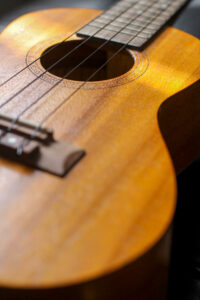 Acoustic guitar sizes and shapes can have a significant impact on the sound of the instrument.
Acoustic guitar sizes and shapes can have a significant impact on the sound of the instrument.The size of the guitar body type also relates to the volume of air within the instrument. Changes to the air capacity of the body will emphasize specific frequencies. A smaller body will have a more focused sound centered on higher frequencies, while a larger body will produce deeper low-end frequencies.
Body dimensions can provide some indication of the tone you might expect, but other factors exert a profound influence, too. Much depends on the tonewoods used to construct the body and the shape, size, and layout of the braces.
Finding Harmony in Acoustic Guitar Sizes
By delving into the nuances of size, sound, and playability, you’ve gained insights that will guide you toward the perfect fit for your musical aspirations.
As you continue your exploration, remember that each acoustic guitar size has its own unique voice and character. Embrace the joy of trying different sizes, celebrate the nuances of their sounds, and let your heart lead you to the one that resonates with your musical soul.
-
Uncategorized
Unveiling the F# Chord: Your Gateway to Melodic Mastery
Hello, aspiring guitarists and music enthusiasts! Are you ready to embark on a musical journey that introduces you to the enchanting world of the F# chord? Today, we’re diving into the captivating universe of the F# chord – a harmonious gem that adds depth and richness to your musical toolbox. Whether you’re a budding guitarist eager to expand your chord knowledge or a curious soul seeking to understand the intricacies of harmony, this guide will lead you through the mesmerizing realm of the “F# Chord.” So, pick up your guitar, find a cozy spot, and let’s explore the harmonious tapestry of musical expression and creativity!
Unraveling the F# Chord: A Touch of Elegance
Imagine the F# chord as a musical thread that weaves elegance and sophistication into your melodies. This chord’s unique tonal quality infuses your music with a sense of richness and depth, making it a versatile choice across various musical genres. Just like an artist selects the perfect brushstroke, the F# chord allows you to paint your sonic canvas with notes that evoke emotion and creativity.
Mastering the F# Chord: Crafting Harmonic Brilliance
Let’s delve into the mechanics of forming the F# chord on your guitar. Follow these steps:
1. Finger Placement: Begin by placing your index finger on the 1st fret of the low E string (the thickest string), marking the root note (F#).
2. Middle Finger: Position your middle finger on the 2nd fret of the G string (the third thinnest string), forming the major third (A# or Bb).
3. Ring Finger: Place your ring finger on the 3rd fret of the D string (the fourth thickest string), creating the perfect fifth (C#).
4. Strumming: Focus on strumming from the A string (the fifth thickest string) down to the high E string (the thinnest string), omitting the low E string (the thickest string) for a cleaner sound.
5. Sound Check: Strum the strings individually to ensure each note rings out clearly. Adjust finger placement if needed for a resonant sound.
Exploring F# Chord Variations: Adding Flair
While the F# chord is inherently elegant, you can add variations to elevate its sonic possibilities. Here are a couple of ways to experiment:
1. Add Arpeggios: Instead of strumming all the strings at once, try playing the notes of the F# chord individually in a sequence to create arpeggios that cascade like a gentle stream.
2. Chord Progressions: Incorporate the F# chord into various chord progressions to create unique musical landscapes that showcase its richness.
The F# Chord in Action: Musical Styles
The F# chord’s distinct and rich quality makes it a favorite choice for songs that demand depth and resonance. Here are a few popular songs that feature the F# chord:
1. “Wonderwall” by Oasis: The F# chord contributes to the iconic strumming pattern that defines this beloved acoustic anthem.
2. “Hotel California” by Eagles: The F# chord adds a layer of sophistication to the intricate guitar harmonies of this classic rock masterpiece.
Tips for Mastering the F# Chord
As you embark on your journey to master the F# chord, consider these tips to enhance your playing:
1. Practice Regularly: Dedicate focused practice time to build muscle memory and finger strength for the F# chord.
2. Smooth Chord Transitions: Work on transitioning smoothly between the F# chord and other chords to improve your overall playing fluency.
3. Experiment with Dynamics: Explore playing the F# chord softly and gradually increasing the volume to add dynamics to your playing.
Conclusion: Embrace the Elegance of the F# Chord
Congratulations, you’ve embarked on a harmonious journey through the captivating universe of the F# chord. As you strum, experiment with variations, and play songs, you’ll discover the power of this chord to infuse your music with richness, depth, and resonance. Keep practicing, keep exploring, and keep embracing the enchanting allure of the F# chord. It’s your key to a world of musical expression, where each note resonates with elegance and sophistication. So, pick up your guitar, let your fingers dance across the strings, and let the captivating world of the F# chord lead you toward a realm of melodies that captivate the heart and elevate the soul, one harmonious note at a time!
Uncategorized
Harmonious Reflection: Embracing Easy Worship Songs on Guitar
In the world of music, there exists a serene space where melodies intertwine with spirituality, creating a harmonious sanctuary for both the musician and the listener. For those who wield the strings of a guitar, this space is illuminated by easy worship songs—a collection of melodies that carry messages of faith, hope, and devotion. Whether you’re a beginner strumming your first chords or an experienced player seeking moments of introspection, easy worship songs on guitar offer a gateway to a meditative and soul-stirring musical journey. In this article, we’ll embark on a melodious exploration of some of these songs, celebrating their simplicity and the spiritual solace they bring.
Simplicity in Harmony
Easy worship songs are characterized by their simplicity—both in terms of chord progressions and lyrical content. These songs are designed to be accessible to players of all skill levels, making them an ideal starting point for beginners who wish to combine their love for music with their spiritual journey.
1. Amazing Grace
“Amazing Grace” stands as a timeless anthem of redemption and grace. With its straightforward chord progression and a melody that gently guides the listener, this song is a perfect introduction to playing worship music on the guitar. As you strum the chords, you’ll not only create music but also evoke a sense of divine presence.
2. What a Beautiful Name
The song “What a Beautiful Name” resonates with themes of adoration and reverence. Its uncomplicated chord structure, combined with heartfelt lyrics, makes it a wonderful choice for those looking to express their faith through music.
3. Blessed Be Your Name
“Blessed Be Your Name” offers a soothing and reflective melody that speaks of gratitude in both times of abundance and trial. Its chord progression is approachable for beginners, while its message is universal and comforting.
4. Here I Am to Worship
“Here I Am to Worship” captures the essence of humility and offering. The song’s simplicity in chords and melody creates a space for introspection, allowing you to connect deeply with the lyrics and find solace in your worship.
5. Oceans (Where Feet May Fail)
“Oceans” invites listeners on a journey of trust and surrender. While its chord changes may present a slight challenge for beginners, the emotional depth of the song and its resonant message make it a rewarding choice for those willing to venture a bit further.
A Spiritual Journey Through Sound
When you strum the chords of easy worship songs on guitar, you’re not just playing music—you’re creating a bridge between the earthly and the divine. Each note you pluck resonates with a message of hope, comfort, and connection, transcending the boundaries of mere sound.
The Joy of Collective Worship
Easy worship songs also find their home within congregations, where a group of individuals comes together to offer their voices in collective worship. Playing these songs on the guitar allows you to contribute to this harmonious symphony of faith, inviting others to join in and share in the spiritual experience.
A Guiding Light for Beginners
For those just beginning their guitar journey, easy worship songs serve as a guiding light. They provide an opportunity to practice basic chord transitions, strumming patterns, and finger placement while engaging in a meaningful and uplifting musical activity.
A Journey of Spirit and Sound
In the embrace of easy worship songs on guitar, you embark on a journey that transcends music alone. You create an intimate connection between your soul, your instrument, and the divine. As you strum and sing, you’re not just producing melodies—you’re weaving a tapestry of faith, hope, and devotion that resonates in the hearts of both the player and the listener. So, whether you’re a beginner seeking to learn your first chords or an experienced guitarist seeking moments of spiritual reflection, easy worship songs on guitar offer a sacred space where sound and spirit intertwine in perfect harmony.
-
advanced9 years ago
How to Play “Sleepwalk” on the 3-String Guitar! Guitar TABs Included!
-
beginner8 years ago
3-String or 4-String? How to Decide Which is Right for You!
-
beginner9 months ago
Exploring Different Guitar Types: A Beginner’s Guide
-
Blues Guitar8 years ago
Go-To Tunings for Blues Slide Guitar
-
advanced9 months ago
Fun and Effective Guitar Exercises: Elevate Your Playing with These 5 Simple Techniques
-
Blues Guitar7 years ago
Jack Daniel’s Whiskey Barrel Guitar: How It’s Made and What it Sounds Like
-
Uncategorized9 months ago
Acoustic Guitar Sizes: Finding Your Perfect Fit
-
Guitars9 months ago
Bass vs Guitar: Exploring the Musical Journey

